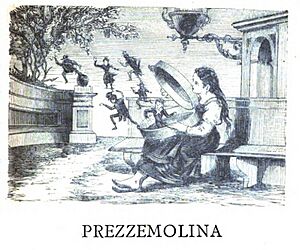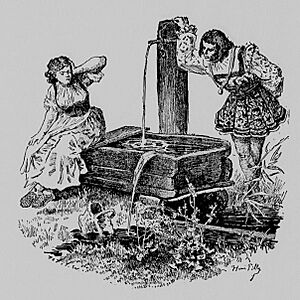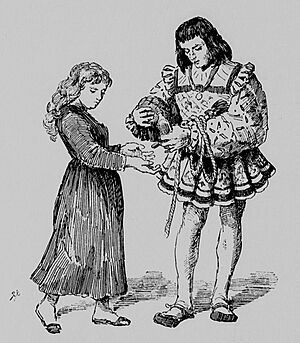Prunella (fairy tale) facts for kids
Prunella is a classic Italian fairy tale that tells the exciting story of a young girl facing challenges. It was originally known as Prezzemolina. The famous storyteller Andrew Lang shared this tale in his book The Grey Fairy Book. This type of story, where a maiden is held captive, is known as Aarne-Thompson type 310. Many versions of this tale have been found across Italy. It's a common theme in fairy tales for a hero to get help with impossible tasks. What makes Prunella special is that the captive is a girl, and her helper is often the captor's son.
Contents
The Story of Prunella
A Girl and a Witch's Plum Tree
A young girl loved to pick plums from a tree on her way to school. Because of this, people called her "Prunella." But the tree belonged to a mean witch. One day, the witch caught Prunella and took her captive. Prunella grew up living in the witch's house.
Impossible Tasks and a Secret Helper
One day, the witch gave Prunella a basket and told her to fill it with water from the well. No matter how hard she tried, the water always leaked out. Prunella began to cry. A kind young man appeared. He introduced himself as Bensiabel, the witch's son. He offered to fill the basket if she would kiss him. Prunella refused, but Bensiabel filled the basket for her anyway. Later, the witch ordered Prunella to bake bread from wheat that hadn't been ground into flour. Prunella knew this was impossible and started to cry. Bensiabel appeared again. She refused his kiss once more, but he still helped her bake the bread.
A Dangerous Journey and Clever Escapes
Finally, the witch sent Prunella on a very dangerous errand. She had to go over the mountains to get a special box from the witch's sister, who was even more cruel. Bensiabel warned Prunella and offered to help her escape if she would kiss him. She still refused. He then gave her some oil, bread, rope, and a broom. He told her to oil the squeaky gate hinges at his aunt's house, feed the fierce dog with the bread, give the rope to a woman struggling at the well, and give the broom to a woman cleaning the fireplace with her tongue. Prunella followed his instructions carefully. She took the box from the cupboard and left quickly. As she ran, the witch's sister called out for everyone to stop her. But they all refused because of Prunella's kindness.
The Witch's Downfall
When Prunella returned, the witch was furious. She ordered Prunella to tell her which rooster crowed during the night. Bensiabel, still hoping for a kiss, told her each time the yellow and black roosters crowed. When the third rooster crowed, Bensiabel hesitated. Prunella begged him to save her. Bensiabel bravely protected Prunella, and the witch had an accident, losing her power forever. Prunella was touched by Bensiabel's goodness. She agreed to marry him, and they lived happily ever after.
Different Versions of the Tale
Prezzemolina: The Parsley Girl
The story first appeared in Italy in 1879 as Prezzemolina. It was collected by Isaia Visentini from Mantua. In this original version, the plant that caused all the trouble was not a plum, but parsley (prezzemolo in Italian). This is similar to the famous tale of Rapunzel. When Andrew Lang shared the story, he changed the plant to a plum and the girl's name to Prunella. Another author, Ruth Manning-Sanders, also adapted the tale. In her book A Book of Witches, the witch's son was named "Benvenuto."
More Adventures of Prezzemolina
In a version from Florence, collected by Italian writer Vittorio Imbriani, Prezzemolina's mother is the one who steals the fairies' parsley. The fairies then claim the girl as payment. Here, a helpful character named Memé, who is a cousin of the fairies, assists Prezzemolina. He helps her with impossible tasks, like painting a room with all the birds of the air.
Memé also guides Prezzemolina on a quest to get a special box from the powerful Morgan le Fay, also known as Fata Morgana. Along the way, Prezzemolina shows kindness to several people and animals. This kindness helps her escape when Fata Morgana tries to stop her. When she opens the box, musicians pop out! Memé helps her put them back. In this story, Memé and Prezzemolina work together to outsmart the evil fairies and break their powerful magic, freeing everyone from their control. They then marry and live happily.
Fragolette: The Strawberry Girl
French author Édouard René de Laboulaye published his own version of the tale. In his story, the special plant was a strawberry, and the heroine was called "Fragolette" (meaning 'little strawberry' in Italian). The hero, the witch's son, was named Belèbon.
The story is set in Mantua. Fragolette is captured by a witch while picking strawberries. The witch forces her to be a servant. Belèbon helps Fragolette with impossible tasks, like filling a leaky basket with water and baking bread from unmilled wheat.
Belèbon also guides Fragolette on a journey to get a strong-box from the witch's sister, Viperine. He gives her special items and advice to help her pass obstacles like a dirty stream, a fierce dog, and squeaky doors. Fragolette follows his instructions and returns safely with the box. In the end, Belèbon helps Fragolette outsmart the witch. The witch's power is broken, and she is no longer a threat. Fragolette is finally free, and she and Belèbon marry and live happily.
Other Adventures and Helpers
Many other versions of this tale exist across Italy, each with unique details.
- In a tale from Genova, the girl is named Prezzemolina. She is taken by ogresses because her mother stole parsley. A magical cat named Gatto-Berlacco helps her with tasks and to escape. The cat turns out to be a cursed prince.
- From Padova, the story of La Bella Parsembolina features a witch's son named Beniamino. He helps Prezzemolina with tasks like washing linen and making a special bed. They work together to defeat the witch.
- A Veronese tale, La storia della Bella Parsemolina, also has a helpful son named Bel Giulio. He uses a magic wand to complete tasks for Prezzemolina and helps her escape the witch's tricks.
- In a version from Castellina in Chianti, fairies take a little girl named Prezzemolina. A small man named Memè helps her with chores and to outsmart the fairies, leading to their happy marriage.
- Other stories, like El fijo de l'Orco from Marche, feature an Ogre's son who helps a girl escape impossible tasks and defeat his father. A Piemontese tale, Mirabé, also tells of a fairy's son helping Prezzemolina's daughter.
These different versions show how a core story can be told in many exciting ways, always featuring a brave young person and a magical helper overcoming challenges.
Why These Stories Matter
Fairy tales like Prunella teach us important lessons. They show that kindness can be a powerful tool, even against the meanest villains. They also remind us that even when faced with impossible tasks, help can come from unexpected places. These stories celebrate courage, cleverness, and the triumph of good over evil.
Related Fairy Tales
- The Tale about Baba-Yaga (Russian fairy tale)
- The Little Girl Sold with the Pears
- La Fada Morgana (Catalan folk tale)
- The Man and the Girl at the Underground Mansion
- Pájaro Verde (Mexican folktale)
- Los Tres Claveles (Spanish folktale)
- Fairer-than-a-Fairy (Caumont de La Force)
- Rapunzel
- Graciosa and Percinet
- Maroula
- Puddocky
- The Enchanted Canary
- The King of Love
- The Magic Swan Geese
- The Two Caskets
- The Water of Life
- The Witch




